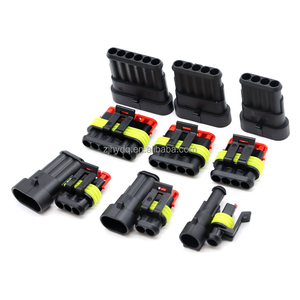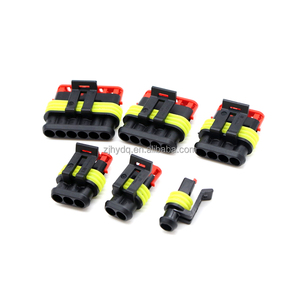
All categories
Featured selections
Trade Assurance
Buyer Central
Help Center
Get the app
Become a supplier

(1197 products available)

















Automotive electrical bulkhead connectors, which mean connectors set between two parts of an electrical system and through a bulkhead or partition, come in various types, depending on what the application requirements are. In this case, these requirements may include the number of circuits desired, cable size, and environmental protection needed. Below are the common types:
Two-Piece Connectors
These bulkhead connectors have a male-female couple that can separate two pieces. Therefore, this feature makes it easier to mount and service, resulting in widespread use in the automotive industry. The real advantage of two-piece connectors is that one can disconnect in order to gain easier access to the components without having to completely dismantle the wiring system, as will be the case with a one-piece connector.
Waterproof Connectors
Waterproof connectors are specifically designed for applications in which exposure to water or moisture is inevitable, such as marine and off-road vehicles. These connectors usually have sealing grommets or O-rings. Their construction is done in a way that effectively prevents water, dust, and debris from penetrating the connector, which protects the connector from damaging the internal electronic components.
High-Current Connectors
These types of connectors are built to support high electrical currents without getting overheated or losing connections in the process. Their usage is common in applications with large power requirements, like electric vehicles, heavy machinery, and commercial trucks. Usually, their construction incorporates wider contact surfaces and better gauge wires to carry larger currents.
ISO Connectors
ISO connectors refer to the types of bulkhead connectors that meet the international standard organization's requirements. This kind of application usually employs these connectors in automotive and electrical systems where there is a need for standardization and interoperability. These connectors ensure that there are compatibility and interchangeability across different manufacturers and vehicles, which makes maintenance and replacement easier.
Multipole Connectors
These connectors are used to transmit multiple signals or power circuits in a single connector. These are mainly used in vehicles where space is limited and many electrical systems need to be integrated. The significance of these multipole connectors is that they help reduce the number of individual connectors and wiring required, which helps in saving space and time during installation.
Material Composition and Their Impact on Durability
Automotive electrical bulkhead connectors are manufactured with a lot of attention to the material they are made of. One should not take this so lightly because the materials involved not only determine electrical conductivity but also overall durability. Below are some key materials used and how it impacts on the connectors' durability:
Many factors determine the suitability of automotive electrical bulkhead connectors for given conditions. Here are some key considerations that assist in making the right choice:
Environmental Sealing
Automotive electrical applications come across various environmental factors, such as dirt, dust, moisture, and extreme temperatures. For this reason, sealing is an important feature. To ought to be sealed effectively, look for connectors with IP (Ingress Protection) ratings, as they are designed to withstand adverse environments. An IP rating of IP67 or above means one can use the connector in indoor and outdoor applications.
Material and Durability
Another factor that plays a very important role in deciding what type of connector to go for is the material used to manufacture. Usually, a connector that has components made of corrosion-resistant materials like stainless steel, brass, or coated alloys is ideal for automotive use. It is equally important to consider the mechanical durability of the connector. One should get connectors that are designed to withstand constant vibration, particularly in situations where the vehicle is subjected to rough terrains.
Current Rating and Power Capacity
Current rating and power capacity must also be compatible with the application. Automotive bulkhead connectors come with different current ratings; using a connector whose current rating is lower than the application's needs might cause overheating and eventual failure. In contrast, a connector with a higher current rating than needed causes overkill, which adds unnecessary costs and weight. Therefore, it is crucial to choose one that is just right: neither under nor over.
Connector Configuration
The configuration, such as how many pins or contacts the connector has, also impacts the choice. There are two configurations: circular and rectangular. Circulars are primarily for lighter applications and provide easy installation and removal features. On the other hand, rectangular connectors are suitable for high density in applications requiring more contacts in space. Ensure the configuration matches the signal and power requirements of the automotive system in which it is to be installed.
Ease of Installation and Maintenance
Installation ease also matters, especially in large automotive electrical systems: the bulkhead connectors should make their installation as easy as possible with minimum effort and time. One nice feature that can be of great help, especially in maintenance and servicing, is the connectors that are designed to be detachable from the system.
A1: Automotive electrical bulkhead connectors bridge two parts of an electrical system through a barrier or partition. These connectors transmit signals, power, or data between the vehicle's internal electrical systems that may be separated by physical bulkheads, such as the engine compartment and the passenger area.
A2: The main function of bulkhead connectors in automotive applications is to provide a reliable means of connecting wires or circuits across a barrier. These are especially useful in situations where the electrical wiring needs to pass through the vehicle's outer body or internal partitions while maintaining separation between different systems.
A3: To prolong the life of electrical bulkhead connectors in automotive applications, keep them in a clean, dry, and cool environment to keep them from overheating or getting moisture and dust that will corrode them. Regular checking and servicing these connectors and replacing connectors that have begun to wear out will go a long way in prolonging their life.
A4: Waterproof bulkhead connectors play a very significant role, particularly in applications exposed to moisture, such as marine and off-road vehicles. These connectors have sealing grommets or O-rings that prevent water, dust, and debris from getting into the electrical system. This will not only protect the system but also ensure it functions properly, even under extreme environmental conditions.
A5: If the vehicle's electrical system requires large amounts of electricity to power such things as electric motors, high-power audio systems, or towing packages, then a high-current connector is needed. Conventional connectors cannot support these applications because they lead to overheating and eventually failure. High-current connectors are designed to handle HVAC currents without any problems, making them ideal for heavy-duty automotive applications.